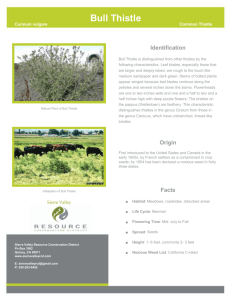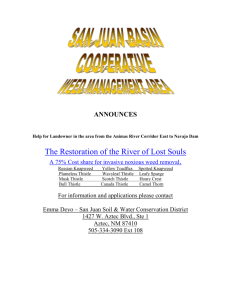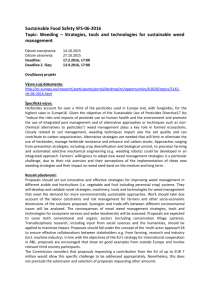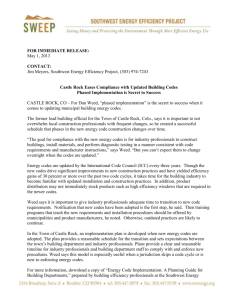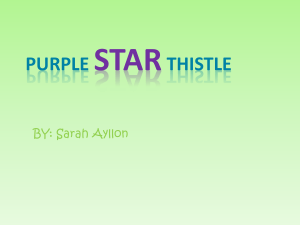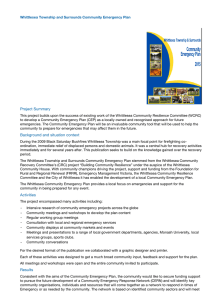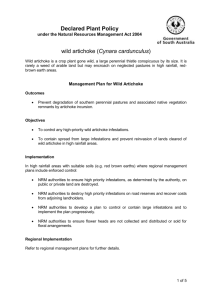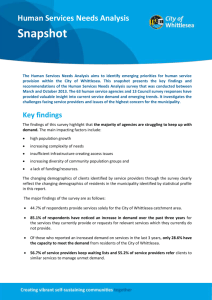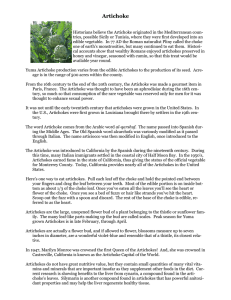Whittlesea weed fact sheet * Artichoke thistle
advertisement
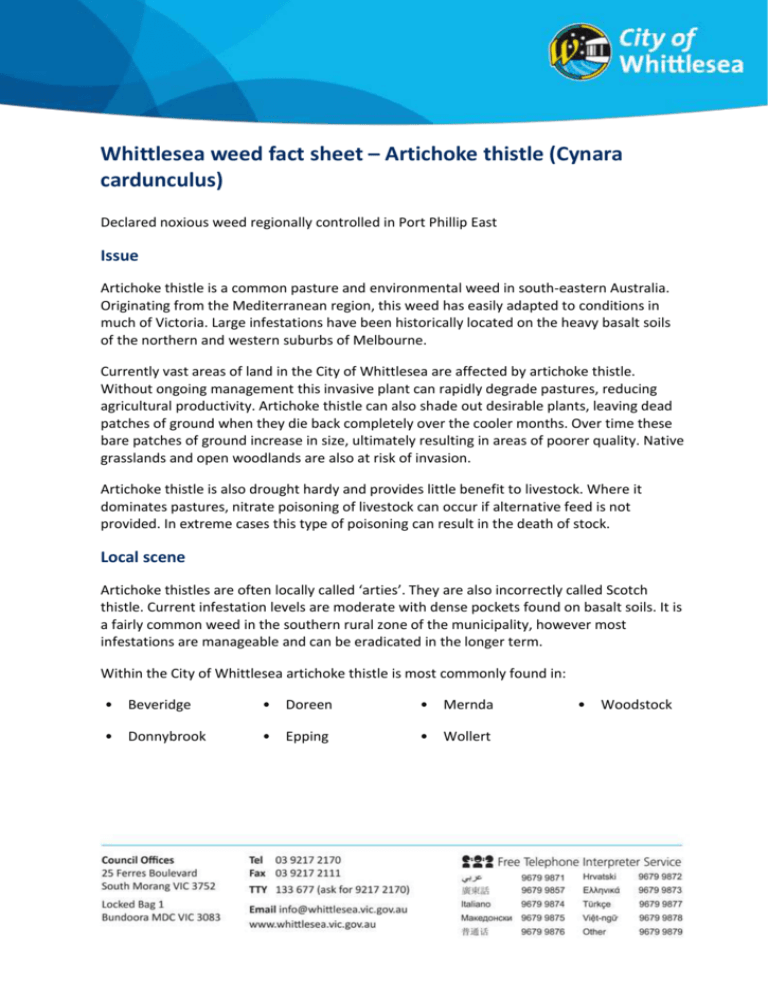
Whittlesea weed fact sheet – Artichoke thistle (Cynara cardunculus) Declared noxious weed regionally controlled in Port Phillip East Issue Artichoke thistle is a common pasture and environmental weed in south-eastern Australia. Originating from the Mediterranean region, this weed has easily adapted to conditions in much of Victoria. Large infestations have been historically located on the heavy basalt soils of the northern and western suburbs of Melbourne. Currently vast areas of land in the City of Whittlesea are affected by artichoke thistle. Without ongoing management this invasive plant can rapidly degrade pastures, reducing agricultural productivity. Artichoke thistle can also shade out desirable plants, leaving dead patches of ground when they die back completely over the cooler months. Over time these bare patches of ground increase in size, ultimately resulting in areas of poorer quality. Native grasslands and open woodlands are also at risk of invasion. Artichoke thistle is also drought hardy and provides little benefit to livestock. Where it dominates pastures, nitrate poisoning of livestock can occur if alternative feed is not provided. In extreme cases this type of poisoning can result in the death of stock. Local scene Artichoke thistles are often locally called ‘arties’. They are also incorrectly called Scotch thistle. Current infestation levels are moderate with dense pockets found on basalt soils. It is a fairly common weed in the southern rural zone of the municipality, however most infestations are manageable and can be eradicated in the longer term. Within the City of Whittlesea artichoke thistle is most commonly found in: • Beveridge • Doreen • Mernda • Donnybrook • Epping • Wollert • Woodstock Problem land management practices Some land management practices contribute to the spread of weeds. Landowners can unintentionally spread artichoke thistles by: • Disturbing soil and creating bare ground • Overgrazing of stock • Importing soil or fill that is contaminated with weed seed • Bringing dirty machinery onto the property that contains weed seed • Careless disposal of flowers and seed heads Selecting the most suitable control technique is crucial. Integrating a number of weed control techniques is often most effective in the longer term. An important part of any weed management program is to maintain control and prevent re-infestation. Re-planting the treated area with desirable plants and regular monitoring is essential to prevent reinfestation. Refer to the City’s ‘Seasonal Guide to Weed Management’ for more information on integrated weed control options. Visit www.whittlesea.vic.gov.au (key word search: seasonal guide) or email Sustainability@whittlesea.vic.gov.au for your copy of the Guide. You may also contact Council’s Sustainable Land Management Officer on (03) 9217 2493 for further weed advice or for a copy of the Guide. Identification tips Flower: Large, round, light green-grey prickly flower buds, up to 15cm in diameter. Buds open into large purple flowerheads in summer. Up to 16 flowers or more, depending on plant vigour, are borne on a single, long stem, up to 1.5-2m tall. In some conditions plants may produce flowers in the first year of growth, however these are normally produced in the second year. Seeds: Once mature, the flower develops into a large white fluffy seed-head. Each plant is capable of producing in excess of 1,600 grey sunflower-like seeds per flowering season. The majority of seeds are usually carried a short distance on a white fluffy appendage called a pappus, commonly known as a “fairy”. Fairies can often be seen drifting on hot northerly winds during late summer. Leaves: Large, prickly leaves, often light greengrey in colouration, although can be slightly darker when growing on fertile land. The leaves are also distinctly deeply divided and covered in a fine downy material. Page 2 of 3 In areas where there is ample water and nutrients the plants can develop leaves measuring up to 1m in length. However, in the City of Whittlesea, the plants are generally less vigorous in growth, with leaves averaging between 30-50cm in length. Form: Deep-rooted, biennial/perennial plant growing from a central point. The leaves form a circular pattern often referred to as a rosette. The plants begin to appear in late autumnspring. Each year these plants die back to a large deep-rooted underground rootstock. Contacts Australian Pesticide and Veterinary Medicines Authority (APVMA) www.apvma.gov.au Tel. (02) 6272 5852 City of Whittlesea Sustainability Planning Unit www.whittlesea.vic.gov.au Tel. (03) 9217 2493 Department of Primary Industries (DPI) www.dpi.vic.gov.au Tel. 136 186 DPI Chemical Information Service www.dpi.vic.gov.au Tel. (03) 9210 9379 Further reading Blood, K (2001) Environmental weeds: a field guide for SE Australia, C H Jerram Science Publishers, Mt Waverley. Keith Turnbull Research Institute (February 1998) Landcare Notes: Artichoke thistle, LC0191, Frankston. Parsons, W.T. & Cuthbertson, E.G. (1992) Noxious Weeds of Australia, Inkata Press, Melbourne. Disclaimer The advice contained in this publication is intended as a source of information only. Always use chemicals in accordance with manufacturer directions on the product label or in Material Safety data sheets available from the manufacturer. The City of Whittlesea and its officers do not guarantee that the publication is without fl aw of any kind or is wholly appropriate for your particular purposes and therefore disclaims all liability for any error, loss or other consequence which may arise from your relying on this information. Page 3 of 3
